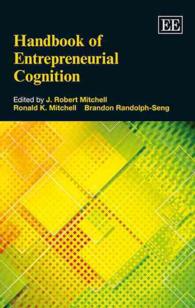- ホーム
- > 洋書
- > 英文書
- > History / World
基本説明
New in paperback. Hardcover was published in 2005.
Full Description
In this original and illuminating new study, Mark Knights reveals how the political culture of the eighteenth century grew out of earlier trends and innovations. Arguing that the period from 1675 needs to be seen as the second stage of a seventeenth-century revolution that ran on until c.1720, Representation and Misrepresentation in Later Stuart Britain charts the growth of a national political culture and traces the development of the public as an arbiter of politics. In doing so, it uncovers a crisis of public discourse and credibility, and finds a political enlightenment rooted in local and national partisan conflict.
The later Stuart period was characterized by frequent elections, the lapse of pre-publication licensing, the emergence of party politics, the creation of a public debt, and ideological conflict over popular sovereignty. These factors combined to enhance the status of the 'public', not least in requiring it to make numerous acts of judgement. Contemporaries from across the political spectrum feared that the public might be misled by the misrepresentations pedalled by their rivals. Each side, and those ostensibly of no side, discerned a culture of passion, slander, libel, lies, hypocrisy, dissimulation, conspiracy, private languages, and fictions. 'Truth' appeared an ambiguous, political matter. Yet the reaction to partisanship was also creative, for it helped to construct an ideal form of political discourse. This was one based on reason rather than passion, on moderation rather than partisan zeal, on critical reading rather than credulity; and an increasing realization that these virtues arose from infrequent rather than frequent elections.
Finding synergies between social, political, religious, scientific, literary, cultural, and intellectual history, Representation and Misrepresentation in Later Stuart Britain reinvigorates the debate about the emergence of 'the public sphere' in the later Stuart period.
Contents
I. REPRESENTATION AND THE PUBLIC ; 1. Introduction ; 2. Public Politics ; 3. Petitions and Addresses ; 4. Informing Public Judgement at the Polls ; II. PUBLIC DISCOURSE AND TRUTH ; 5. The Evolution of Print Culture and the Libels of Public Discourse ; 6. Truth and Fiction in the Age of Party ; 7. Consequences ; Appendix: The Principal Periodicals in the Reign of Queen Anne ; Select Bibliography








